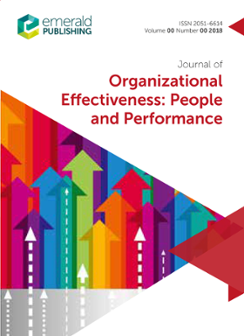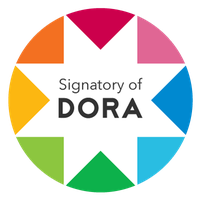Journal of Organizational Effectiveness: People and Performance
Issue(s) available: 41 – From Volume: 1 Issue: 1, to Volume: 11 Issue: 1

A systematic literature review on sustainable HRM and its relations with employees' attitudes: state of art and future research agenda
Gabriela Pedro Gomes, Arnaldo Coelho, Neuza RibeiroThe interest in sustainable human resource management has grown in the last decades. However, comprehensive, and systematic research concentrating on the evolution of this field…
Managerial coaching and taking charge at work: the mediating roles of work engagement and role breadth self-efficacy
Michelle She Min Ngo, Michael J. Mustafa, Craig Lee, Rob HallakHow does a manager’s coaching behaviour encourage taking charge behaviour among subordinates? Although prior research has found a positive association between managerial coaching…
Time perspectives and collaborative performance in creative tasks
Thorsten Auer, Julia Amelie Hoppe, Kirsten ThommesThe relationship between variation in time perspectives and collaborative performance is scarcely explored, and even less is known about the respective mechanisms that lead to…
A nexus of affective events theory and viable system model to comprehend affective work environment holistically – an empirical investigation
Iffat Sabir Chaudhry, Angela EspinosaDespite being a seminal explanation of the workforce emotional experiences, capable of mapping the path from the antecedents to consequences, affective events theory (AET) only…
Does spiritual leadership promote employees’ green creativity? The mediating effect of green work engagement
Ahmad Abualigah, Kamal BadarAnchored in the conservation of resources (COR) theory, this research aims to examine the effect of spiritual leadership on green creativity via the mediating role of green work…
Performance appraisal process as a determinant of employee commitment: a serial mediation analysis
Charles Anyeng Ambilichu, Godbless Onoriode Akaighe, Dennis Gabriel PeppleThis study draws on Organisation Justice Theory and Social Exchange Theory to examine the effects of the performance appraisal process (PAP) on employee commitment (ECO) via a…
Should I adopt AI during talent acquisition? Evidence from HR professionals of Indian IT organisations
Ramesh Sattu, Simanchala Das, Lalatendu Kesari JenaThe purpose of our study was two-fold: (1) to examine the effect of perceived value derived from perceived benefits and sacrifices in the adoption of artificial intelligence (AI…
Reviewing executive remuneration decision-making and reporting: implications for theory and practice
Stephen J. Perkins, Susan ShortlandThe purpose of this viewpoint is to comment on the implications of the Financial Reporting Council’s (FRC) Review and Consultation Documents expected to update regulation…
Commitment-based HRM and inbound open innovation in SMEs: the role of organizational trust and developmental culture
Elona Cera, Gentjan Cera, Enis EleziAlthough scholars have been studying human resource management (HRM) and open innovation (OI), yet there is less attention to this relationship in the context of small-and…
Inclusive leader and job crafting: the role of work engagement and job autonomy in service sector organisations
Aqsa Jaleel, Muhammad SarmadThe ever-demanding role of employees in the hospitality sector stimulates job crafting. This study examines the relationship between inclusive leadership and job-crafting…
HR analytics-as-practice: a systematic literature review
Yanina Espegren, Mårten HugossonHuman resource analytics (HRA) is an HR activity that companies and academics increasingly pay attention to. Existing literature conceptualises HRA mostly from an objectivist…
“If you want peace avoid interpersonal conflict”: a moderating role of organizational climate
Anurag Singh, Neelam WaldiaThis study examines the impact of interpersonal conflict on workplace aggression. Moreover, the moderating role in the association between interpersonal conflict and workplace…
The interactive effect of individual and co-worker narcissism on counterproductive work behavior
Valerie A. Chambers, Matthew J. Hayes, Philip M.J. ReckersCounterproductive work behavior (CWB) imposes significant costs on organizations, thus antecedents of CWB are of particular interest to both practitioners and academics. The…
Religiosity as a buffer of the harmful effects of workplace loneliness on negative work rumination and job performance
Muhammad Umer Azeem, Dirk De Clercq, Inam Ul HaqThis study investigates how employees' experience of resource-depleting workplace loneliness may steer them away from performance-enhancing work efforts as informed by their…
How job resources can shape perspectives that lead to better performance: a remote worker field study
Justin B. Keeler, Noelle F. Scuderi, Meagan E. Brock Baskin, Patricia C. Jordan, Laura M. MeadeThe purpose of this study is to investigate the complexity of how demands and stress are mitigated to enhance employee performance in remote working arrangements.
Learning from the working from home experiment during COVID-19: employees motivation to continue working from home
Hannah Kira Wilson, Matthew Tucker, Gemma DaleThis research investigates the challenges and benefits of working from home and the needs that organisations should understand when adopting working from home practices.
Elevating organizational effectiveness: synthesizing human resource management with sustainable performance alignment
Yushi Jiang, Sobia Jamil, Syed Imran Zaman, Syeda Anum FatimaThis paper investigates the interactional relationships between sustainable human resource management (SHRM) and organizational performance (OP). Sustainable HRM is an approach…
Impact of strategic HR practices on innovation performance: examining the mediation of differentiation and cost-effectiveness
Karishma Trivedi, Kailash B.L. SrivastavaInnovation is critical for businesses to stay competitive in today's world, as it allows them to constantly look for new ways to differentiate their products or services from…
Does workplace ostracism lead to workplace withdrawal? Testing the moderating-mediating effects of rumination and mindfulness in Indian hospitality industry
Shalini Srivastava, Muskan Khan, Arpana Kumari, Ajay Kumar JainTaking the support of social capital theory and conservation of resource theory, the present study explores the mediating role of rumination and moderating role of mindfulness in…
Agile SHRM practices and employee-organisational outcomes during new normal: evidence from India and Thailand
Sarawut Pathomphatthaphan, Simanchala Das, Lalatendu Kesari JenaThe purpose of the cross-cultural study is three-fold – (1) to examine the effect of agile strategic human resource management (ASHRM) practices for each stage of the employee…
Transformation leadership's emotional labor and follower's psychological capital: mediating effect of emotional contagion
Neerja Kashive, Bhavna RainaThe study aims to closely look at the phenomenon of transformational leadership and the psychological capital of followers by using affective process theory (APT). It has…
Performance management systems in a shared service centre: an exploration of organisational injustice
Lauri Lepistö, Sinikka LepistöThis study aims to explain how negative workplace interactions are formed by the application of a performance management system (PMS).
Should I stay or move on—examining the roles of knowledge sharing system, job crafting, and meaningfulness in work in influencing employees' intention to stay
Parul Malik, Pooja MalikBased on the affective events and self-concept theories, this study aims to examine the relationship between knowledge sharing system, job crafting, meaningfulness in work and…
How servant leadership influences the effectiveness of project management: antecedents and consequences
Muhammad Zada, Jawad Khan, Imran Saeed, Shagufta ZadaThis study investigates the link between servant leadership and project management effectiveness in developmental projects in non-governmental organisations (NGOs). Further, this…
Dynamic nexus between Smart HR 4.0 and innovation ambidexterity: a fuzzy-TISM and MICMAC approach
Gopal Krushna Gouda, Binita TiwariSmart HR 4.0 is a new concept characterized by adopting innovative technologies of Industry 4.0 (I4.0) in the HR domain. This study attempts to identify the key factors of Smart…
Interplay between servant leadership, leader-member-exchange and perceived organizational support: a moderated mediation model
Mohammad Nisar Khattak, Moyassar Zuhair Al-Taie, Ifzal Ahmed, Noor MuhammadThis study aims to investigate the effect of servant leadership on employee organizational identification and career satisfaction through the mediating lens of…
Agile work practices and team creativity: the mediating role of team efficacy
Ram Shankar Uraon, Rashmi Bharati, Kritika Sahu, Anshu ChauhanThis study aims to examine the impact of two dimensions of agile work practices (i.e. agile taskwork and agile teamwork) on team efficacy and creativity. Further, it examines the…
Multi-level outcomes of learning organisation: a bibliometric analysis and future research agenda
Sunil Budhiraja, Mohini Yadav, Neerpal RathiBecoming a learning organisation (LO) is an aspiration for every organisation as it offers internal capabilities, a competitive advantage and synergy gains to organisational…
Leaders' Machiavellianism and subordinates' task performance: a multilevel investigation
Sharjeel Saleem, Louise Tourigny, Yasir Mansoor Kundi, Muhammad Mustafa Raziq, Aqsa GoharThis study aims at analyzing the detrimental cross-level serial effects of leaders' Machiavellianism and abusive supervision on subordinates' burnout and task performance. The…
Transformational leadership and employees' work engagement: the simple and parallel mediation of self-efficacy and trust in the leader
Faqir Sajjad Ul Hassan, Malik IkramullahThe importance of transformational leadership (TFL) for improving followers’ work engagement (WE) has been highlighted by management researchers, but little is known about how and…
Dynamic capabilities of the SMEs for sustainable innovation performance: role of environmental turbulence
Seyedeh Khadijeh Taghizadeh, Syed Abidur Rahman, Davoud Nikbin, Malgorzata Radomska, Shaghayegh Maleki FarThis study aims to investigate how dynamic capabilities, i.e. sensing, learning, integrating and coordinating trigger sustainable innovation performance. It also examines the…
The effects of working from home during the COVID-19 pandemic on work–life balance, work–family conflict and employee burnout
Afaf Khalid, Usman Raja, Abdur Rahman Malik, Sadia JahanzebDespite the extent of working from home (WFH) during the coronavirus disease 2019 (COVID-19) pandemic, research exploring its positive or negative effects is exceptionally scarce…
Climate of fear and job apathy as fallout of supervisory nonphysical hostility toward casual workers in the banking industry
Ibeawuchi K. Enwereuzor, Amuche B. Onyishi, Fumnanya EkwesarannaSupervisory abuse is a form of destructive leadership. Research has continued to document many deleterious consequences associated with such improper behavior at work. This study…
I'm only here for the donuts: stand-up meeting relevance's effects on work meaningfulness and motivation
Isaac A. Lindquist, Joseph A. Allen, William S. KramerStand-up meetings have received attention for their functional effectiveness in the workplace, but they can also cause affective reactions among attendees. These reactions can…
“Look before you leap”: comparing the turnover intention of nurses as public servants and private employees
Carla Freire, Adriano AzevedoIn recent decades, human resource management (HRM) in health organizations has faced several problems associated with employees' efficiency and happiness, which has been…
Humble leadership and project success: underpinning service-oriented organizational citizenship behavior and task complexity
Nisma Naeem Mian, Muhammad Imran Malik, Saddam HussainThe aim of the study is to investigate the relationship between humble leadership, project success, and service-oriented organizational citizenship behavior (OCB) and how task…
Do union strategic influence, job security and the industrial relations climate matter for the adoption of high performance work systems?
Danat Valizade, Hugh Cook, Chris Forde, Robert MacKenzieThe paper aims to explore the role of union strategic influence on the adoption of High Performance Work Systems (HPWS) in organisations and examines how the effects of job…
The impact of intellectual capital-enhancing HR practices and culture on innovativeness—mediating role of knowledge management processes
Karishma Trivedi, Kailash B.L. SrivastavaThe study examines the effect of human and social capital-supporting human resource (HR) practices and structural capital-supporting culture on innovativeness and the mediating…
Exploring the influence of risk management on the performance of industry–university collaborative projects: the moderating role of knowledge management capabilities
Mohammad DaradkehEffective management of risk and knowledge is critical to ensure the success of industry–university collaboration (IUC) projects. However, the intricate dynamics through which…
“I am the captain of my soul!” choosing where to work: impact on general well-being and organizational commitment
Debolina Dutta, Chaitali Vedak, Anasha Kannan PoyilThe COVID-19 pandemic found deliberate and idiosyncratic adoption of telecommuting and other flexibility practices across industries. With the pandemic waning, many organizations…
Management's internal governance policies on flexible work practices and the mediating lens of work life enrichment – Outcome for employee work engagement and organizational attractiveness
Asif Khan, Ashfaq Khan, Tazeem Ali Shah, Mohammad Nisar Khattak, Rawan AbukhaitUsing Pakistan's public sector higher education institutions as the study site, this study aims to empirically substantiate, under the theoretical underpinnings of job enrichment…
ISSN:
2051-6614Online date, start – end:
2014Copyright Holder:
Emerald Publishing LimitedOpen Access:
hybridEditor:
- Professor Maura Sheehan
